Last Updated on January 23, 2024 by Greg Gillson
I’ve put this resource together for you to answer your question: What birds are in my backyard in North Dakota?
This article lists and discusses the identification of the most common birds in your backyard. The birds chosen in this article are compiled from actual data from the citizen science program eBird. Thus, it is more accurate than some other similar articles you may find on the web. I provide pictures of each bird species mentioned. I tell how to attract them to your backyard.
These are the most common backyard birds in North Dakota:
- American Robin
- Red-winged Blackbird
- Mourning Dove
- Common Grackle
- Black-capped Chickadee
- House Sparrow
- American Goldfinch
- American Crow
- Western Meadowlark
- White-breasted Nuthatch
- Song Sparrow
- Downy Woodpecker
- Chipping Sparrow
- Brown-headed Cowbird
- Barn Swallow
- European Staling
- House Finch
- Blue Jay
- Northern Flicker
- Dark-eyed Junco
- Hairy Woodpecker
- Common Redpoll
- Red-breasted Nuthatch
- Eastern Kingbird
- Western Kingbird
- House Wren
- Cliff Swallow
North Dakota Birds and Birding in North Dakota State
eBird lists over 405 types of birds as occurring in the state of North Dakota.
The most common bird in North Dakota: the most
frequently seen bird in the state is American Robin. It is reported on 39%
of bird watching lists.
If you are serious about knowing the birds native to North Dakota, then check out eBird for North Dakota. It has recent sightings and photos, illustrated checklists with weekly abundance bar charts for state, counties, and individual hotspots of the best birding locations.
If you want to know about other people interested in birds in your area, join a local bird group. The American Birding Association maintains a list of bird watching clubs for each state.
North Dakota Bird Identification
This section is the species accounts. These are designed to help you to recognize birds you see in your backyard. I have used eBird to select the birds that are most common. “Common” means the birds seen most often throughout the year, not necessarily the most numerous.
Each species account starts with a photograph. In the identification section I am using size and shape and bill type before considering the color or patterns on the birds. I find these more reliable when trying to identify an unknown bird. Pay attention to body and tail shape and especially bill shape of birds you see, not just plumage color.
In the section on bird feeders and foods I tell how to attract each species. Not all types of backyard birds will come to feeders. But all backyard birds can be attracted with water. So don’t forget to add a birdbath to your bird feeding station.
Do you live in New Hampshire?
To appear in this article, most birds are widely distributed throughout the state and are often year-round residents. However, for those birds that are more localized in place or time, I list the general region and seasonality. Please see the section following these species accounts for the lists of common species by season.
Even if a species is found in a general area, they occur only in the habitat they prefer. So, the exact habitat of your neighborhood is important for the presence of absence of certain kinds of birds.
1. American Robin (Turdus migratorius)
This familiar bird is a resident in the northern half of the United States and a winter visitor in the southern half.
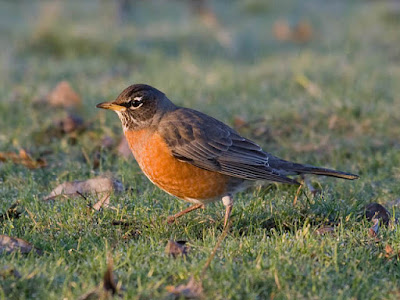 |
| American Robin. Greg Gillson. |
Range in North Dakota: American Robins are summer residents throughout North Dakota.
Identification: This is a key species for comparing with an unknown bird.
Size: 10 inches long from bill tip to tail tip. About the same size as a Blue Jay or one of the Scrub-Jays. Larger than Red-winged Blackbird. Smaller than a Mourning Dove.
Shape: Very plump with a fairly long tail.
Bill: Straight and fairly slender, curved at the tip.
Color: Gray-brown upperparts, rusty orange breast.
Habitat, range & behavior: Open woodlands, farmlands, urban parks and lawns.
Migratory, breeds north across Alaska and Canada. Resident in most of the United States (lower 48). Winters in the United States, Mexico, to central America.
Hops on your lawn turning head this way and that looking for food. Their caroling song is one of the early signs of spring in the north.
Food and feeder preference: American Robins eat earthworms and other invertebrates in the lawn. May eat fruit from a tray feeder or the ground. Eat small berries from trees and bushes.
2. Red-winged Blackbird (Agelaius phoeniceus)
These noisy flocking birds are most often found in marshes. But in winter they are found in backyards.
 |
| Male Red-winged Blackbird. Greg Gillson. |
 |
| Female Red-winged Blackbird. Greg Gillson. |
Range in North Dakota: Red-winged Blackbirds are summer residents throughout North Dakota, year-round residents in central and southeastern North Dakota.
Identification: This is a key species for comparing with an unknown bird.
Size: About 8-3/4 inches long from bill tip to tail tip. About the size of a Northern Cardinal. Smaller than an American Robin.
Shape: Pot-bellied with a longer bill and flat forehead. Tail average.
Bill: Long and sharp pointed.
Color: Males are black with red and yellow shoulder patch. Females are streaked brown and rusty (sparrow-like but pointed bill and flat forehead).
Habitat, range, and behavior: Cattail marshes and wetlands are their summer habitat. In winter they feed in grain fields.
They breed across most of the North American continent. In winter they withdraw from most of Alaska and Canada.
They are found in colonies in summer and large flocks in winter.
Food and feeder preference: They eat insects in summer. In winter they eat grain and seeds. They visit feeders, more often in large winter flocks, and eat most seeds and suet.
3. Mourning Dove (Zenaida macroura)
Mourning Doves are the most widespread and most frequent backyard bird in the Lower 48 states of the United States.
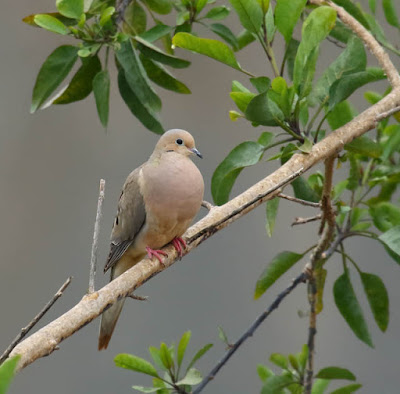 |
| Mourning Dove. Greg Gillson. |
Range in North Dakota: Mourning Doves are summer residents throughout North Dakota.
Identification: This is a key species for comparing with an unknown bird.
Size: About 12 inches long from bill tip to tail tip. About same size as Northern Flicker. Larger than American Robin. Slightly smaller than domestic city pigeon.
Shape: Very plump with a small round head. Tail is long and pointed. Legs are short.
Bill: Small and rather slender.
Color: Pale brown-pink body, darker wings and tail. White edges on side of tail.
Habitat, range & behavior: Semi-open areas such as urban areas, farmlands, woods. Often seen perched on wires, fences.
It is a resident across the lower-48 states and Mexico, with some movement out of northern areas in winter.
Their mournful cooing is a familiar spring birdsong.
Food and feeder preference: Mourning Doves eat seeds almost exclusively. Attract with black oil sunflower seeds on a large sturdy tray feeder or on the ground.
4. Common Grackle (Quiscalus quiscula)
Sometimes considered a pest to crops, grackles are longer and lankier than very similar blackbirds.
 |
| Common Grackle. GeorgiaLens from Pixabay |
Range in North Dakota: Common Grackles are summer residents throughout North Dakota.
Identification:
Size: Larger than Red-winged Blackbirds, they are near the length of Mourning Doves.
Shape: Long, with long full keel-shaped tail, long legs, flat crown.
Bill: Longer than head, pointed, but stouter than other blackbirds.
Color: Glossy black with hint of bronze or green on head (depending upon population). Yellow eye.
Habitat, range & behavior: They are found in agricultural areas, woodland edges, city parks and lawns.
Resident in the southeastern United States. In summer they migrate northward and west to the central United States and Canada.
They monopolize feeders and are bullies toward other birds.
Food and feeder preference: Grain, corn, acorns, small aquatic fish and amphibians. To discourage them, use tube feeders, rather than hopper or tray feeders. Don’t over-feed, keep spilled seed picked up.
5. Black-capped Chickadee (Poecile atricapillus)
This is a common backyard bird in the northern half of the United States.
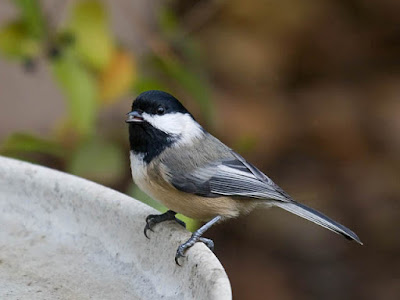 |
| Black-capped Chickadee. Greg Gillson |
Range in North Dakota: Black-capped Chickadees are year-round residents throughout North Dakota.
Identification:
Size: Chickadees are small birds, the same general size as an American Goldfinch.
Shape: Round body, big round head, long tail with rounded tip.
Bill: Short, straight, stout.
Color: Gray above, buffy below. Black cap and bib with white lower face. White edges on wing feathers.
Habitat, range & behavior: Deciduous and mixed forests.
They range from the northern half of the United States, southern half of Canada, and most of Alaska.
Small flocks flit actively from tree to tree acrobatically gleaning insects from twig tips. In winter chickadees make up the core of mixed-species flocks also containing nuthatches, kinglets, creepers, woodpeckers and others.
Food and feeder preference: Seeds, insects, berries. They eat at tube, hopper and tray feeders. They love black oil sunflower seeds and suet.
You may like my in-depth article on attracting Black-capped Chickadees.
6. House Sparrow (Passer domesticus)
Like the starling, this is another bird introduced from Europe in the 1800’s. This sparrow is commonly found in cities and farmlands. It is considered a pest in most areas where it has been introduced.
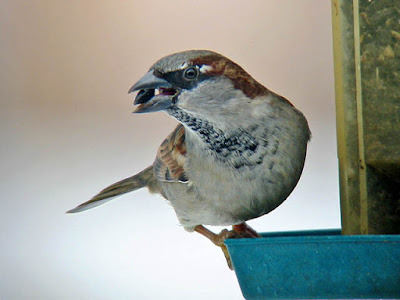 |
| House Sparrow. Greg Gillson |
Range in North Dakota: House Sparrows are year-round residents throughout North Dakota.
Identification:
Size: The size of a House Finch or Dark-eyed Junco.
Shape: Chunkier than native North American sparrows with large head, barrel chest, short neck, medium tail, short legs.
Bill: Short, conical.
Color: Males are brown and gray with a black mask. Females lack the black and are tan and brown with a pale line back from the eye.
Habitat, range & behavior: Cities and farms.
Range in North American from southern Canada through Central America. In summer northward through Canada to southern Alaska. Originated in Middle East and spread to most of Europe and Asia. Introduced in South America, Africa, Australia–nearly anywhere there are people and cities.
They tend to be messy… and have a good appetite, and may occur in large noisy chirping flocks. They are aggressive toward other feeder birds.
Food and feeder preference: They eat grain, seed, and insects. To discourage them from your hopper and tray feeders do not feed birds human food scraps. They have a bit of difficulty eating from tube feeders.
7. American Goldfinch (Spinus tristis)
A beautiful tiny finch familiar to many in its bright yellow summer plumage. Colloquially called a “wild canary.”
 |
| American Goldfinch. Greg Gillson |
Range in North Dakota: American Goldfinches are summer residents throughout North Dakota.
Identification: This is a key species for comparing with an unknown bird.
Size: Very small at about 5 inches from bill tip to tail tip. Similar in size to a chickadee. Larger than hummingbirds. Smaller than juncos and House Finches.
Shape: Tiny, somewhat plump with larger head and short tail.
Bill: Short, conical, pink.
Color: Males in summer are bright lemon yellow with black forehead and black wings and tail with white bars. White under tail coverts. Females dull olive, wings and tail browner. Winter birds are pale grayish-yellow with tan and brown wings and tail.
Habitat, range & behavior: This species is found in weedy fields and similar clearings with thistles and similar plants.
It is found coast-to-coast throughout the year across most of the middle lower-48 states. In summer moves north to the Canada border. In the winter found south to the Mexico border.
The flight is highly undulating, rising and falling as they flap in short bursts.
Besides a long, sweet lilting song, they call in flight a lilting 4-part: “potato chip!”
Food and feeder preference: Feeds on weed seeds, thistle seed. May eat black oil sunflower seeds from tube feeder. Love Nyjer seed in a feeder called a “thistle sock.”
You may like my in-depth article on attracting American Goldfinches.
8. American Crow (Corvus brachyrhynchos)
This larger all black bird is common in cities and country. Its cawing call is familiar to most people.
 |
| American Crow. Greg Gillson. |
Range in North Dakota: American Crows are summer residents throughout North Dakota.
Identification: This is a key species for comparing with an unknown bird.
Size: About 17-1/2 inches long from bill tip to tail tip, though there is much size variation throughout its range. Larger than blackbirds and grackles. Smaller than ravens.
Shape: Thick neck, large head, rather short square-ended tail. Longer legs. In flight has rounded wing tips with each primary feather separated from others forming “fingers.”
Bill: As long as head, thick, black.
Color: Glossy black throughout.
Habitat, range & behavior: They prefer open areas with trees, fields, farms, cities.
They are common across most of the United States lower-48, except in the desert southwest. They move into southern Canada in summer.
They gather in evening communal roosts in large flocks that may number into the thousands and then move out at dawn into the surrounding area.
Food and feeder preference: Omnivorous, American Crows feed on large insects, grain, small mammals, carrion. You probably don’t want these large entirely black birds in your backyard feeders. So don’t feed table scraps to birds.
9. Western Meadowlark (Sturnella neglecta)
These are beautiful songsters of the prairie grasslands.
 |
| Western Meadowlark. Greg Gillson. |
Range in North Dakota: Western Meadowlarks are summer residents throughout North Dakota.
Identification:
Size: Bigger than a European Starling, smaller than an American Robin.
Shape: Stocky and pot-bellied, with short tail and flat forehead profile.
Bill: Long, straight, and sharp pointed.
Color: Straw and brown-colored upper parts. Bright yellow below with black necklace. White outer tail feathers. Duller in winter.
Habitat, range, & behavior: Fields, pastures, prairies.
The summer across the West from the Great Lakes to the Pacific, and western Canada to western Texas, and into Mexico. Move out of Canada in winter and spread to Gulf Coast.
Forage on fields and bare grounds, often found with cattle. In flocks in winter.
Foods and feeder preference: Grain and insects. They do not come to feeders.
10. White-breasted Nuthatch (Sitta carolinensis)
A favorite feeder bird for many for its active antics and fearlessness. Though a small bird it is the largest nuthatch in North America.
 |
| White-breasted Nuthatch. Greg Gillson |
Range in North Dakota: White-breasted Nuthatches are year-round residents throughout North Dakota.
Identification:
Size: About chickadee-sized in length. Smaller than a junco or House Finch.
Shape: Appears large-headed, neckless, very short tailed. Short legs.
Bill: Nearly as long as head, straight, thin.
Color: Blue-gray above, white below. Black cap, wing tips, tail. Rusty feathers under tail.
Habitat, range & behavior: Common in oak and oak-pine woodlands, wooded towns.
Found across the United States, southern Canada, mountains of central Mexico. Absent from treeless grasslands, deserts in the west.
Crawls over tree branches and head-first down tree trunks searching for insects.
Food and feeder preference: Insects, seeds, acorns and other nuts. Love black oil sunflower seeds feeding on hopper and tray feeders. Suet blocks.
11. Song Sparrow (Melospiza melodia)
A common bird, but variable, and similar to many other streaked brown sparrows.
 |
| Song Sparrow. Greg Gillson. |
Range in North Dakota: Song Sparrows are summer residents throughout North Dakota.
Identification:
Size: A smaller bird, similar in size to House Finch and juncos. Larger than chickadees and goldfinches. Smaller than White-crowned Sparrows or Spotted/Eastern towhees.
Shape: Plump with round head, long rounded tail.
Bill: Short, conical.
Color: Highly variable in darkness and color saturation across its range (dark rusty to pale gray). Generally gray-brown above with dark brown streaking on back. Complicated head pattern. Streaking on sides and breast converge into dense central breast spot.
Habitat, range & behavior: Thickets, especially near water. Backyard shrubbery.
Resident in western United States, western Canada, coastal southern Alaska, northeastern US. In summer also moves into mid-Canada and northern half of US. In the winter found in most of the US lower-48. Also a population in central Mexico.
Forages on ground, never far from low cover to which they fly if startled.
Food and feeder preference: Song Sparrows feed on seeds and insects near the ground. Will visit hopper and tray feeders for mixed bird seed.
12. Downy Woodpecker (Dryobates pubescens)
This tiny woodpecker is found across the United States.
 |
| Downy Woodpecker. Greg Gillson |
Range in North Dakota: Downy Woodpeckers are year-round residents throughout North Dakota.
Identification:
Size: Bigger than a junco or House Finch. Smaller than a Red-winged Blackbird. About the same size as a White-crowned Sparrow, but with a much shorter tail.
Shape: Stocky with large head and short stiff tail.
Bill: Short, chisel shaped.
Color: Black-and-white striped head. Black wings with white spots. Solid white back. White under parts. Black tail with white outer tail feathers with black bars or spots. Male with small red spot at back of head.
Habitat, range & behavior: Found in small deciduous trees, willows, and even weed stocks such as teasel, especially near water.
Ranges coast-to-coast across all but northernmost parts of Canada and Alaska south to the southern US. Absent in the desert southwest.
Interestingly, I learned today that the males may more often be found in smaller plants and twigs, while females are more likely on tree trunks.
Food and feeder preference: Insects, fruits, and seeds. Gleans arthropods from the bark of trees. Attract with suet feeder. Will also eat black oil sunflower seeds.
13. Chipping Sparrow (Spizella passerina)
Chipping Sparrows are a widespread species adapted to human disturbance. They are rather tame. They are frequently found in cemeteries with large trees.
 |
| Chipping Sparrow. Greg Gillson. |
Range in North Dakota: Chipping Sparrows are summer residents throughout North Dakota.
Identification:
Size: These are small sparrows, bigger than goldfinches or chickadees, but smaller than House Finches or Song Sparrows.
Shape: Plump and fairly long-tailed.
Bill: Short and conical.
Color: Striped brown and dark brown above. Grayish under parts. Black line through eye. Crown streaked in winter but in summer becomes solid chestnut. Two white wing bars.
Habitat, range & behavior: Grassy open conifer woodlands with some shrubs, parks, orchards.
Breeds from Alaska, across Canada and south into highlands of Middle America. In winter retreats from northern areas to southern United States and northern Mexico.
In summer solitary or in pairs. In winter they forage in flocks of up to 50 birds.
Food and feeder preference: Weed seeds, supplemented with insects in summer. They may eat black oil sunflower seeds in your feeder, but more likely will feed on mixed seeds on the ground under the feeder.
14. Brown-headed Cowbird (Molothrus ater)
Cowbirds are small blackbirds lay their eggs in the nests of other smaller birds, such as warblers. The adoptive parents raise their young!
 |
| Brown-headed Cowbird. Greg Gillson. |
Range in North Dakota: Brown-headed Cowbirds are summer residents throughout North Dakota.
Identification:
Size: Larger than White-crowned Sparrows, but smaller than Rose-breasted or Black-headed Grosbeaks. Smaller than other blackbirds, starlings, and grackles.
Shape: Perhaps a little bit pot-bellied. Medium length tail. Flat forehead as typical for blackbirds.
Bill: Rather thick and stout.
Color: Males are glossy black with rich brown head. Females are dusty gray-brown throughout. Long-held juvenile plumage similar to pale female, scaly, being fed by Yellow Warbler or Song Sparrow or a hundred other host species.
Habitat, range & behavior: They are found in woodlands and farms. Also with other blackbirds in winter at shopping center parking lots.
In summer they breed across Canada and most of the United States and Mexico. In winter they move south out of Canada and occupy both coasts and southeastern States in the US.
These small blackbirds join other flocks of blackbirds in cattle feedlots. You may see cowbirds riding on the backs of cattle, sheep, or horses. They originally rode on the backs of American bison on the Great Plains, but expanded when forests were cut.
Food and feeder preference: Cowbirds eat grains, seeds, and insects. They will readily come to hopper and platform feeders. They are larger and more aggressive, so keep other birds from feeders and have a big appetite!
15. Barn Swallow (Hirundo rustica)
These swallows are widely distributed throughout the world, primarily breeding in the northern hemisphere, and wintering in the mid-latitudes and southern hemisphere.
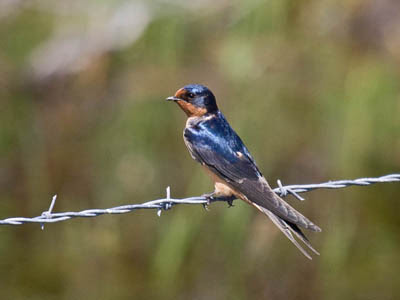 |
| Barn Swallow. Greg Gillson. |
Range in North Dakota: Barn Swallows are summer residents throughout North Dakota.
Identification:
Size: About the size of a House Finch but with a much longer tail.
Shape: Stocky, short necked but with long body and tail. Tail is forked, with very long outer tail feathers. Wings pointed.
Bill: Short, wide.
Color: Glossy dark purplish-blue above. Pinkish-orange below.
Habitat, range & behavior: Barn Swallows live in open country, frequently near humans. Farmlands. Nest in barns, under small bridges.
In North America breed from Mexico to northern Canada and Alaska, wintering from southern Mexico throughout most of South America.
Frequently seen swooping low over the ground hunting flying insects. Perch on wires, fences. Voice is twitters and chirps with grating sounds.
Food and feeder preference: Eat flying insects on the wing and are not attracted to backyard feeders.
16. European Starling (Sturnus vulgaris)
Introduced to North America in the late 1800’s, they crossed the continent, often to the detriment of native cavity-nesting birds. The prime example of an invasive species.
 |
| European Starling. Greg Gillson. |
Range in North Dakota: European Starlings are year-round residents throughout North Dakota.
Identification:
Size: About the size of a Red-winged Blackbird. Smaller than an American Robin. Larger than a White-crowned Sparrow or Spotted/Eastern towhee.
Shape: Stocky with large head, short square-ended tail. Longer legs.
Bill: As long as head. Sharp pointed. Yellow in spring, otherwise dark.
Color: They are grayish brown much of the year, with glossy iridescence and white spotting during the spring.
Habitat, range & behavior: Lowland birds that need trees large enough for nest cavities but plenty of open area for feeding. They are most abundant in urban and suburban areas where they find food and artificial nest cavities.
Resident from coast-to-coast from southern Canada to northern Mexico. In summer north across Canada and Alaska. Native range is Europe to Pakistan, north Africa.
Often viewed as a pest, starlings often bully other backyard birds, taking over bird feeders, and stealing nest cavities from smaller native birds.
In winter they can form into flocks of ten’s of thousands.
Food and feeder preference: European Starlings eat primarily insects when available, often feeding on the ground. Discourage them from your backyard hopper and tray feeders by never feeding birds table scraps (including bread or meat). They have weak feet and do not perch well on tube feeders. A cage mesh around smaller hopper feeders may keep them out.
17. House Finch (Haemorhous mexicanus)
These are one of the most common backyard birds in the United States. There are other red finches, but these are the ones most likely in residential areas.
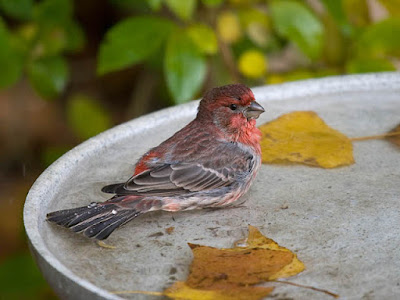 |
| House Finch. Greg Gillson. |
Range in North Dakota: House Finches are year-round residents throughout North Dakota.
Identification: This is a key species for comparing with an unknown bird.
Size: About 6 inches from bill tip to tail tip. Larger than goldfinches and chickadees. Smaller than a White-crowned Sparrows or Spotted/Eastern towhees.
Shape: Medium build with a medium-long notched tail. Round head.
Bill: Short, conical.
Color: Brown and gray above with streaks on the sides of the pale underparts. Males with red (sometimes orange or rarely yellow) crown, chest, rump.
Habitat, range & behavior: You’ll find small flocks on wires, in short tree tops and in bushes. Originally deserts and grasslands. Rural areas and towns are where they’re now most common.
Formerly found in the western United States and Mexico. Then introduced into the northeastern United States, but now found in nearly all of the lower-48 states and extreme southern Canada. Rare in plains states (Dakotas to Texas) and southern Florida.
House Finches are not territorial, but males sing throughout the year–a lively, wiry song ending in a couple of buzzy notes.
Food and feeder preference: House Finches love sunflower seeds and tube feeders. May eat from thistle socks.
You may like my in-depth article on attracting House Finches.
18. Blue Jay (Cyanocitta cristata)
A common and well-known bird in the eastern half of the United States.
 |
| Blue Jay. skeeze from Pixabay |
Range in North Dakota: Blue Jays are year-round residents throughout North Dakota.
Identification:
Size: About that of American Robin.
Shape: Fluffy, large crested head, ample tail. Large strong legs.
Bill: Black, long and stout.
Color: Blue above, white below. Black neck collar. White patches in wing.
Habitat, range & behavior: Woodlands and towns in the eastern half of the United States. In summer into southern Canada.
Bold and brash. May bully smaller birds. Jays gulp lots of seeds or other food at once, storing it in their crop. Then they fly off and bury food items in a hidden cache.
Food and feeder preference: Omnivorous. They can quickly empty your feeder! Because they are also aggressive toward other feeder birds, some people put mesh cages around smaller bird feeders. Small birds can go through, squirrels and larger “pest” birds are prevented entry. Some people feed jays peanuts, perhaps away from the seed feeders.
19. Northern Flicker (Colaptes auratus)
Of all the bird identification questions I get asked, this common larger backyard bird is the bird most people ask about. It doesn’t occur to those unfamiliar with it that this could be a woodpecker.
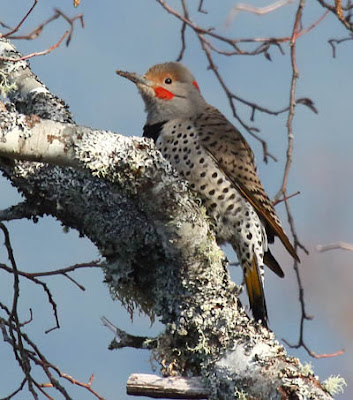 |
| Northern Flicker. Greg Gillson. |
Range in North Dakota: Northern Flickers are year-round residents throughout North Dakota.
Identification:
Size: About the size of a Mourning Dove. Larger than a robin.
Shape: Stocky with short legs, short tail, big head.
Bill: As long as head, thin, slightly curved.
Color: Back is brown with black bars. Under parts pinkish with black spots. Undersides of black wing and tail feathers are bright salmon red (West) or yellow (East). Head gray (West) or brown (East) and males with red (West) or black (East) whisker marks and nape marks (East). Black crescent across chest. White rump seen in flight.
Habitat, range & behavior: Found in woodland edges and forests.
Year-round resident from extreme southern Canada, across all of the lower-48 states and in the mountains of Mexico and Middle America. In summer breeds northward well into Canada and Alaska.
Frequently noted hopping on ground pecking in the ground for insects. In late spring, males proclaim their territory by rapid pounding on a hollow tree branch, though the ringing of metal downspouts at dawn is louder and carries much farther, to the exasperation of anyone trying to sleep inside!
Food and feeder preference: Ants and beetles are their primary foods. Will eat black oil sunflower seeds and are attracted to suet.
20. Dark-eyed Junco (Junco hyemalis)
Colloquially called “snow birds,” they often arrive in backyards in winter from nearby mountain forests or more northern climes.
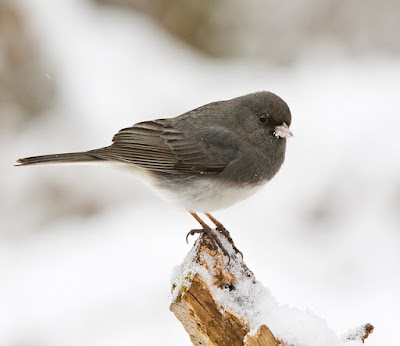 |
| Dark-eyed Junco. skeeze from Pixabay |
Range in North Dakota: Dark-eyed Juncos are winter visitors throughout North Dakota.
Identification:
Size: Small birds about the size of a House Finch.
Shape: Round body, short neck, round head, fairly long square-ended tail.
Bill: Short, pointed, conical, pink.
Color: Eastern birds are a darker all-gray with white belly. Western birds have jet black hood over head, brown back, and pink sides.
Habitat, range & behavior: Breed in coniferous forests. Winters widely. Avoids heavy brush, preferring widely spaced bushes.
Breeds across most of Canada, Alaska, and the western half of the United States. Winters from southern Canada and all of the lower 48-states to extreme northern Mexico.
Spend much of their time hopping and feeding on the ground.
Food and feeder preference: Eats mostly seeds, also insects in summer. Readily feed at backyard feeders on mixed seeds on hopper or tray feeders and ground.
You may like my in-depth article on attracting Dark-eyed Juncos.
21. Hairy Woodpecker (Dryobates villosus)
Hairy Woodpeckers appear in plumage almost exactly as Downy Woodpeckers. Hairy Woodpeckers are slightly larger with a heavier and longer bill.
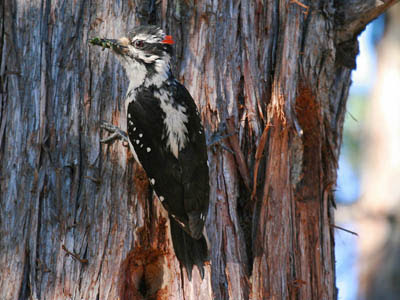 |
| Hairy Woodpecker. Greg Gillson. |
Range in North Dakota: Hairy Woodpeckers are year-round residents throughout most of North Dakota, abasent in northwestern North Dakota.
Identification:
Size: Slightly larger than Downy Woodpecker. Same size as Red-bellied or Acorn Woodpeckers. Much smaller than flickers.
Shape: Stout body. Large head. Short pointed tail. Short legs, large feet. Short rounded wings.
Bill: Slightly shorter than head. Stout. Chisel-shaped.
Color: Wings and upper parts generally black. White back. Black and white lines on face. Under parts white. Male with red spot on nape.
Habitat, range & behavior: They are found on large trees in open or dense forests.
These birds are widespread across North America except for treeless deserts and grasslands.
These birds are almost always found on trunks or heavy branches of large trees, often conifers. This is different from Downy Woodpeckers which are frequently on small branches, weed stalks, willows.
Food and feeder preference: Eat primarily insects. However, they will come to feeders in winter for suet, peanuts, and sunflower seeds from hopper or platform feeders.
22. Common Redpoll (Acanthis flammea)
These tiny pale red finches of the Arctic barely reach the northern United States in winter.
 |
| Common Redpoll. Greg Gillson. |
Range in North Dakota: Common Redpolls are winter visitors throughout North Dakota, though more regular in the northeastern half of North Dakota.
Identification:
Size: Tiny, the size of American Goldfinch.
Shape: Plump with short, forked tail. Round head.
Bill: Small, short, thick base, pointed. Yellow.
Color: Very pale. Frosty white with brown streaks. Red cap on top of head. Black around bill. Male with pink blush across chest.
Habitat, range & behavior: Breeding at edge of tundra and boreal forest. Alder. Birch. In winter weedy fields, towns.
Breed across Alaska, northern Canada, Greenland. In winter they move south, still in southern Alaska, across Canada, and south to northern tier of states. Irregularly to mid-latitude states of US.
They forage in flocks, often eating seeds of birch, alder, spruce, weed seeds.
Food and feeder preference: Their diet is seeds and insects. Look for them in birch trees. At feeders attract with white proso millet and Niger seed from thistle feeders.
23. Red-breasted Nuthatch (Sitta canadensis)
These small birds are common in conifer groves and mountain forests.
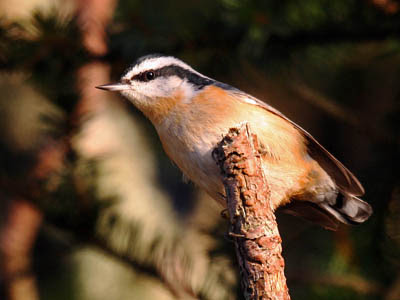 |
| Red-breasted Nuthatch. Greg Gillson. |
Range in North Dakota: Red-breasted Nuthatches are winter visitors throughout North Dakota.
Identification:
Size: Smaller than Black-capped Chickadees and American Goldfinches, larger than kinglets.
Shape: Compact body with large head on short neck. Stubby tail.
Bill: Fairly long and sharp-pointed.
Color: Dark blue-gray back and upper parts. Black crown and line through eye, showing long white eyebrow. White face and rusty underparts. Females paler.
Habitat, range & behavior: Conifer trees in forests and residential areas.
Found from Alaska and across Canada, mountains of Northeast and much of the West. Winter visitor south throughout most of the United States.
Crawls actively on bark on tree trunks and around smaller branches, often head-first down the tree.
Food and feeder preference: Eat insects and invertebrates. Cache nuts and seeds in fall to eat later in the winter. At feeders eat sunflower seeds, peanuts, other nuts from hopper and tube feeders, and suet.
24. Eastern Kingbird (Tyrannus tyrannus)
These birds often build nests in trees that overhang streams.
 |
| Eastern Kingbird. Greg Gillson. |
Range in North Dakota: Eastern Kingbirds are summer residents throughout North Dakota.
Size: About the size of a Red-winged Blackbird. Smaller than a robin.
Shape: Fairly sleek. Perches upright with big puffy head, full tail.
Bill: Fairly long, wide at base,
Color: Black head. Black tail with white band at tip. Dark gray upper parts. White under parts.
Habitat, range & behavior: Farms, clearings in woodlands.
Found across Canada and in the United States east from the Rocky Mountains.
These birds perch on fence lines, tips of small trees. Sally out and snatch flying insects and return to perch.
Food and feeder preference: They eat insects and do not come to feeders.
25. Western Kingbird (Tyrannus verticalis)
You may note these birds aggressively and noisily chasing off other birds, such as crows and hawks, from their territories. And other interloping Western Kingbirds, of course.
 |
| Western Kingbird. Greg Gillson. |
Range in North Dakota: Western Kingbirds are summer residents throughout North Dakota.
Identification:
Size: Larger than phoebes. Smaller than American Robins. The same size as Red-winged Blackbirds.
Shape: Long body with heavy chest. Large head with raised hind crown. Large bill. Long full tail. Upright posture.
Bill: Fairly long, but shorter than head, stout and wide at the base.
Color: Gray head, back, and chest. Yellow belly. Brown wings. Black tail with contrasting white outer tail feathers.
Habitat, range & behavior: Open country.
Summers in the western half of the United States and adjacent southern Canada.
Perches on electric wires, fence lines. Chases flying insects and returns to perch.
Food and feeder preference: Feeds on flying insects. Does not come to feeders.
26. House Wren (Troglodytes aedon)
These birds will readily use nest boxes to raise their young.
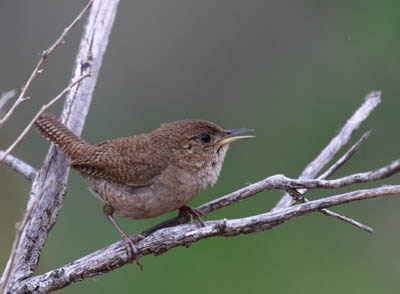 |
| House Wren. Greg Gillson. |
Range in North Dakota: House Wrens are summer residents throughout North Dakota.
Identification:
Size: About the size of Black-capped Chickadee but with shorter tail.
Shape: Round body. Large head. Thin short tail.
Bill: Fairly long, thin, slightly down curved. Sharply pointed.
Color: Rather dull brownish gray throughout. Paler throat and breast. Tail barred with black and pale bars along with the brown.
Habitat, range & behavior: Brushy areas, woodland edges, hedge rows, tree stumps in logged areas.
Breed across Canada and the northern and mid-latitudes of the United States. Winter to the southern United States and through Mexico. Found year round at southern edge of breeding range: California, North Carolina to northern Alabama, southern Arizona south through mountains of Mexico.
Stay hidden in brushy areas. Hop among tree roots, logged stumps.
Food and feeder preference: May feed at suet feeder.
27. Cliff Swallow (Petrochelidon pyrrhonota)
These colonial-nesting birds build gourd-shaped mud nests on cliffs, under the eaves of barns, and under highway overpasses. You will most often notice them in flight.
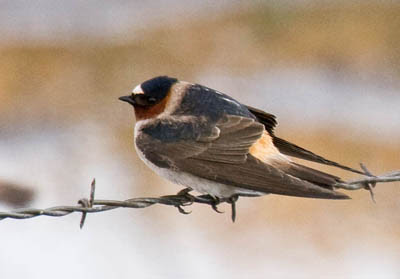 |
| Cliff Swallow. Greg Gillson. |
Range in North Dakota: Cliff Swallows are summer residents throughout North Dakota.
Identification:
Size: Small birds, smaller than House Finches, larger than American Goldfinches.
Shape: In flight note round head, short square tail, pointed wings.
Bill: Short, wide.
Color: Dark blue back with pale stripes, dark wings and tail. Pale under parts. Large buff rump patch. Crown dark blue. Throat dark rusty. White forehead.
Habitat, range, and behavior: Fly over open country, canyons, farmlands.
In summer they occur nearly everywhere from Alaska and Canada southward through Mexico. Leave entire region in winter.
Fly high chasing bugs, skimming over ponds, trapping them against cliffs. In spring you may note them at mud puddles scooping up bills full of mud to build their nests. In fall migration more likely to be noted on roadside wires.
Food and feeder preference: Feed on flying insects. Do not occur at feeder.
Common Birds in North Dakota
To determine how common each species is I used the data from actual bird sightings from the citizen science program eBird. Birds are listed by frequency. That is, how often the species is recorded on checklists submitted to eBird (a percentage).
When choosing the birds to include in this article I leaned strongly to birds that are present throughout the year in good numbers. Thus, many of the common birds are
year-round residents. This means that they live in the same location all year. They raise their young in your neighborhood. They don’t migrate. Or if the species does migrate, the ones living in your area don’t. If this is the case, some migrants may move into your area during certain times of year, adding to the same species that are in your yard full time.
Some migrant birds visit your yard during the “summer.” Often, they arrive in spring and remain until late fall. They nest and raise their young in your neighborhood. These are the summer residents.
Other migrant birds visit your backyard during the “winter.” Some of these winter visitors may arrive in July and remain into April. Others may only be found in the cold of December or January. They key here is that they nest and raise their young somewhere else. They only visit your yard in the non-breeding season.
Migration is an amazing spectacle. There will be birds that fly through your region in spring or fall (or both). They may visit your backyard only a few days or weeks a year. They aren’t regular enough, or stay long enough, to be included in this article. But the number of briefly visiting migrant birds could double the number of species presented here. You may see them over time. Consult checklists in eBird for your county to see what is possible.
I have generally excluded common waterfowl, birds of prey, shorebirds, seabirds, and others that aren’t usually found in residential areas. But they may certainly fly over or be seen regularly if your home is on a shoreline, for instance.
Most common backyard birds in North Dakota throughout the year
The following list is the backyard birds that are, on average, most common throughout the entire year. The list is ordered by most common based on the frequency of how often each species is recorded on checklists submitted to eBird.
The most common backyard birds throughout the year in the state of North Dakota, in order, are these:
- American Robin (39% frequency)
- Red-winged Blackbird (32%)
- Mourning Dove (31%)
- Common Grackle (28%)
- Black-capped Chickadee (28%)
- House Sparrow (23%)
- American Goldfinch (23%)
- American Crow (21%)
- Western Meadowlark (21%)
- White-breasted Nuthatch (20%)
- Song Sparrow (18%)
- Downy Woodpecker (18%)
- Chipping Sparrow (17%)
- Brown-headed Cowbird (17%)
- Barn Swallow (16%)
- European Staling (15%)
- House Finch (15%)
- Blue Jay (15%)
- Northern Flicker (14%)
- Dark-eyed Junco (14%)
Most common backyard birds in North Dakota in winter
- Black-capped Chickadee (43% frequency)
- House Sparrow (33%)
- White-breasted Nuthatch (31%)
- Downy Woodpecker (28%)
- Hairy Woodpecker (21%)
- Dark-eyed Junco (20%)
- Blue Jay (20%)
- House Finch (19%)
- Common Redpoll (17%)
- American Crow (16%)
- Red-breasted Nuthatch (13%)
- European Starling (13%)
Most common backyard birds in North Dakota in summer
- Red-winged Blackbird (54% frequency)
- Mourning Dove (51%)
- American Robin (44%)
- Western Meadowlark (43%)
- Common Grackle (41%)
- Brown-headed Cowbird (39%)
- Eastern Kingbird (37%)
- American Goldfinch (35%)
- Barn Swallow (33%)
- Song Sparrow (29%)
- Western Kingbird (26%)
- House Wren (24%)
- Chipping Sparrow (23%)
- Cliff Swallow (20%)
- House Sparrow (18%)
- American Crow (18%)
Red-winged Blackbirds, Mourning Doves, American Robins, Western Meadowlarks, Common Grackles, Brown-headed Cowbirds, Eastern Kingbirds, American Goldfinches, Barn Swallows, Song Sparrows, Western Kingbirds, House Wrens, Chipping Sparrows, Cliff Swallows are more common in summer than in winter in North Dakota.
Black-capped Chickadees, House Sparrows, White-breasted Nuthatches, Downy Woodpeckers, Common Redpolls, Red-breasted Nuthatches are more common in winter than in summer in North Dakota.
Common Backyard Birds of Bismark, North Dakota
- American Robin (50% frequency)
- Mourning Dove (38%)
- Common Grackle (37%)
- Black-capped Chickadee (34%)
- Red-winged Blackbird (34%)
- House Sparrow (29%)
- European Starling (26%)
- Northern Flicker (23%)
- American Goldfinch (22%)
- Downy Woodpecker (21%)
- Song Sparrow (20%)
- Eurasian Collared-Dove (20%) Learn about this species on eBird
- White-breasted Nuthatch (18%)
- House Finch (18%)
- Barn Swallow (17%)
American Robins, European Starlings are more common in Bismark than the state average in North Dakota.
Common Backyard Birds of Fargo, North Dakota
- Black-capped Chickadee (44% frequency)
- American Robin (40%)
- White-breasted Nuthatch (37%)
- American Crow (35%)
- Downy Woodpecker (30%)
- House Sparrow (29%)
- Common Grackle (24%)
- Dark-eyed Junco (24%)
- Hairy Woodpecker (23%)
- Blue Jay (21%)
- Mourning Dove (21%)
- House Finch (20%)
- Song Sparrow (19%)
- Chipping Sparrow (19%)
- Red-winged Blackbird (19%)
- American Goldfinch (19%)
Black-capped Chickadees, White-breasted Nuthatches, American Crows, Downy Woodpeckers, Dark-eyed Juncos are more common in Fargo than the state average for North Dakota.
Red-winged Blackbirds, Mourning Doves are less common in Fargo than the average for North Dakota as a whole.
Common Backyard Birds of Minot, North Dakota
- Black-capped Chickadee (46% frequency)
- American Robin (46%)
- American Goldfinch (33%)
- American Crow (32%)
- Mourning Dove (32%)
- House Sparrow (31%)
- Red-winged Blackbird (30%)
- Downy Woodpecker (30%)
- Common Grackle (29%)
- White-breasted Nuthatch (29%)
- Song Sparrow (26%)
- Hairy Woodpecker (23%)
- Blue Jay (23%)
- House Finch (17%)
- Brown-headed Cowbird (17%)
Black-capped Chickadees, American Goldfinches, American Crows, Downy Woodpeckers are more common in Minot that the average for the state of North Dakota.
Wrapping Up
North Dakota is a great state for some backyard birding but if you are feeling adventurous, then there are many other exciting birds to be found in a variety of habitats offered by the state. Here are some of them:
Grasslands:
- Western Meadowlark: This state bird of North Dakota is known for its beautiful song and its bright yellow breast. They are found in open grasslands and prairies.
- Baird’s Sparrow: This small sparrow is found in shortgrass prairies and is named after Spencer Fullerton Baird, the first curator of birds at the Smithsonian Institution.
- Grasshopper Sparrow: This sparrow is named for its grasshopper-like call and is found in tallgrass prairies.
- Ring-necked Pheasant: This introduced game bird is now common in North Dakota’s grasslands and farms.
- Northern Harrier: This hawk is also known as the mouse hawk and is found in open areas where it hunts for small mammals.
Wetlands:
- Mallard: This common duck is found in ponds, lakes, and rivers throughout North Dakota.
- Blue-winged Teal: This small duck is found in freshwater marshes and ponds.
- American Coot: This large, chicken-like bird is found in freshwater marshes and ponds.
- Great Egret: This tall, white heron is found in marshes, swamps, and along rivers.
- Sandhill Crane: This large, long-legged bird is found in wetlands and prairies.
Frequently Asked Questions
Are there cuckoo birds in North Dakota?
Yes, there are cuckoo birds in North Dakota! However, only one species, the Black-billed Cuckoo, is considered fairly common to rare in the state.
Here’s some information about the Black-billed Cuckoo in North Dakota:
- Habitat: They prefer brushy margins or woodland openings, thickets of small trees and prairie shrubs. You might also find them in riparian areas, shelterbelts, and wooded areas of towns and farmsteads.
- Seasonality: They are migratory birds, arriving in North Dakota from mid-May to mid-September, with peak breeding season being mid-June to late July.
- Appearance: Slender, long-tailed birds with brown upperparts and off-white underneath. They have a black bill and red eye ring, which distinguishes them from the yellow-billed cuckoo.
- Conservation status: Black-billed cuckoos are declining across North America and are included on the USFWS Bird of Conservation Concern list.
While less common, there have been rare sightings of other cuckoo species in North Dakota, such as the Yellow-billed Cuckoo and the Greater Roadrunner.
What is the state bird of North Dakota?
The state bird of North Dakota is the Western Meadowlark (Sturnella neglecta). It was officially designated in 1947.
This beautiful songbird is about the size of a robin and has a distinctive appearance:
- Bright yellow breast with a black bib
- Mostly brown upperparts with white streaks
- Long, pointed bill
- White outer tail feathers that flash when in flight
Western Meadowlarks are common throughout North Dakota, especially in grasslands, prairies, and open fields. They are known for their melodic songs, which often brighten the landscape.
Choosing the Western Meadowlark as the state bird was a popular decision, as it represents the grasslands and prairies that are such an important part of North Dakota’s ecology and culture.
Are Blue Jays common in North Dakota?
The presence of Blue Jays in North Dakota depends on the specific location within the state:
Generally:
- Blue Jays are not considered common throughout North Dakota.
- They are more frequently found in the eastern and central parts of the state, where there are more mature deciduous forests with oak trees, their preferred habitat.
- They are uncommon to rare in the western part of the state, where the landscape is dominated by prairies and grasslands.
Historical records:
- Early explorers like Lewis and Clark did not mention Blue Jays in their journals during their travels through North Dakota.
- In 1975, they were considered fairly common in the Red River Valley and the Turtle Mountains, as well as fairly common in much of the central part of the state.
Reasons for their relative scarcity:
- The dominant oak woodlands found in their eastern range are less prevalent in North Dakota.
- The state’s winters can be harsh, reducing their overall numbers compared to more southerly regions.
However:
- Blue Jays can be found year-round in North Dakota, adapting to the available food sources and habitat.
- They are intelligent and resilient birds, and their populations may fluctuate depending on environmental factors.
So, while not as widespread as in other parts of the country, Blue Jays can still be spotted in North Dakota, especially in the eastern and central regions.
Related Articles:
34 of the most common birds in the United States (with photos)










